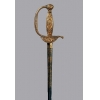|
 Today, cold
steel arms enjoy a revival as they emerge not as a real weapon but a unique and
precious collector's item. That said, both fire and cold steel arms are highly
valued but the latter enjoys a much greater demand. This is especially true with
regard to smallswords which are appreciated for their delicate shape and
elegance as well as for their precious beauty (in their time, most swords were expensive
weaponry decorated with precious metals and stones). Probably, their popularity
can be explained by the perception of smallswords as a weapon of noblemen, officers
and generals. Today, cold
steel arms enjoy a revival as they emerge not as a real weapon but a unique and
precious collector's item. That said, both fire and cold steel arms are highly
valued but the latter enjoys a much greater demand. This is especially true with
regard to smallswords which are appreciated for their delicate shape and
elegance as well as for their precious beauty (in their time, most swords were expensive
weaponry decorated with precious metals and stones). Probably, their popularity
can be explained by the perception of smallswords as a weapon of noblemen, officers
and generals.
The smallsword
is a light one-handed sword designed for thrusting which evolved out of the
longer and heavier rapier of the late Renaissance. From times immemorial, cold
steel arms in general, and swords in particular were not only a part of
military gear, but also an object of admiration, a work of art, that would make
its owner proud. It was the ultimate man's attribute that bore the engraving of
their owner's coat of arms. Today, buying an authentic antique smallword can be
tricky as they are very expensive and stored mostly in museums and private
collections. What's more, smallwords are highly valued because of their history,
as swords had another purpose: they were symbols.
The height
of the smallsword's popularity was between mid 17th and late 18th century. It
is thought to have appeared in France and spread quickly across the rest of
Europe. The small sword was the immediate predecessor of the French foil. Smallswords
were also used as status symbols and fashion accessories; for most of the 18th
century anyone, civilian or military, with pretensions to gentlemanly status
would have worn a small sword on a daily basis.
The
noblemen, the warrior class wore smallswords when unarmored, when in civilian
dress. The powerful merchants then wore swords too as symbols of power and for
the sake of fashion. Duels, which had once been a means to settle disputes
between nobles, started spreading to civilians. The art of defense (hence fencing)
became ubiquitous. The sport of fencing was formed. Thus the smallsword evolved
from use in battle to use duels and sport.
Since that
time, smallsword has become a symbol of nobleman's pride; a recognized emblem
of honor the carrying of which was regulated by certain formalities. The owners
often «customized» their smallswords by decorating it with jewels, took special
care of their precious weapon and valued it above anything else. Pawning a
sword was despicable, an equivalent to losing one's honor. To deny the right to
carry a smallsword was a punishment that is why the procedure of forfeiture of
title in Russia (so called «civil execution») included public breaking of
nobleman's sword, a ritual of the ultimate disgrace.
The history
of smallsword as a weapon was over by Napoleon era. Militarily, smallswords
continued to be used as a standard sidearm for infantry officers. In some
branches with strong traditions, this practice continues to the modern day,
albeit for ceremonial and formal dress only. The carrying of swords by officers
in combat conditions was frequent in World War I and still saw some practice in
World War II. Today, smallsword are still featured on parade uniforms of some
corps.
The
production of replicas of historical smallswords originates with 19th century
historicism. Contemporary replicas can range from cheap factory produced
look-alikes to exact recreations of individual artifacts, including an
approximation of the historical production methods. Most high quality swords
(replicas) may be found in lands that first adapted to the idea of this weapon,
or which later improved it. Authentic smallswords are very hard to find and
their prices are soaring high. However, they can be a valuable addition to your
cold steel arms collection and a nice decorative touch as well as excellent
investment in times of crisis, as with proper care a smallsword can be stored
for centuries. Richly decorated noblemen's swords of fine craftsmanship are
less valued though they look more like a precious work of art than a lethal
weapon. Collectors also highly value original smallswords bearing the intricate
engravings; especially those with long history that might probably belong to
some outstanding people. Ordinary military smallswords are prized as remarkable
cold steel arms.
Certainly,
every collector who holds a smallsword in their possession can be proud,
because to some extent having a smallsword is equivalent to owning a fragment
of history and standing in line with those officers and noblemen who once
defended their honor with this fine weapon.
|